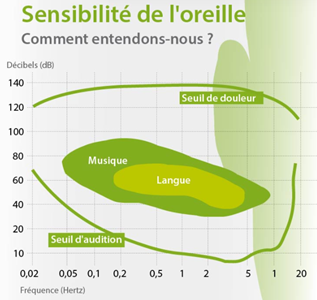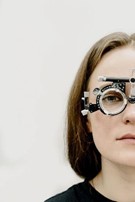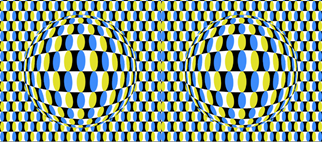
Training content development
Perception (gnosis) refers to the ability to perceive an object through our different senses (vision, hearing, smell, touch, taste) and then to recognise it.
The development of the part of the brain that perceives what is around us depends on several factors:
- Genetics
- Stimulation
- Adaptation
Stimulation can be internal or external.
External stimuli are distinguished by the sense that detects them:
- Auditory stimulus, when a sound determines the excitation
- Visual stimulus, when the reaction to an image or a light is studied
- Tactile stimulus, with pressure or pricks on the skin
- Thermal stimulus, with a heat or cold source
- Olfactory stimulus with a smell
- Gustatory stimulus on the oral receptors
Hearing, smell, vision, taste, touch are the five senses involved by external stimulations called stimuli.
But perception is more than just receiving data. Information from the outside world is selected, decoded and interpreted. Perception is an interpretation of reality.
So there is 3 stages of stimuli reception: sensory, perceptual and cognitive.
- The sensory stage of stimuli reception
Let’s take an example: I look at the sky at night. Many stars twinkle against a black background. The back of my eye is lined with receptor cells that collect the rays of light emitted by the stars. Each of these receptors is connected via the optic nerves to neurons specialised in vision. Some are specialised in analysing brightness, others in colour, and still others in movement. If a point of light starts to move in the sky, an aeroplane for example, it will immediately be detected by the movement sensors in my eyes. This first phase of perception is therefore a sensory stage, which passes through specialised receptors and enables us to identify the characteristics of the external environment.
- The perceptive stage of stimuli reception
This is the second stage. Although the stars are scattered across the sky, in no apparent order, the brain tends to spontaneously group together the stars that are close to each other: the constellations. This perceptual processing consists of going beyond the sensory data to put them into shape, to give things a certain coherence.
- The cognitive stage of stimuli reception
The third stage is the interpretation of the data. The constellation of the Great Bear appears to us in the form of a large saucepan or a chariot. It is according to the representations of an era, its cultural models, that we will give an interpretation to these perceptive forms. This cognitive stage consists in attributing a meaning to the information according to our knowledge. A Martian, or someone from another civilisation (who had never seen a saucepan), might not have grouped the same stars together, nor given the same name to his set of stars.
- What is it?
Human hearing has the extraordinary ability to disentangle sound waves from speech and to make sense of the expression of acoustic signals. Sound vibrations arriving at the outer part of the ear are conducted through the ear canal to the eardrum. The eardrum amplifies the vibrations which are then transmitted to the inner ear. A mechanical wave propagates and transforms the sound signal into an electrical signal: a nervous message is created and will be transported to the brain by the auditory nerve.

Source: auditionsante.fr
- Example
The range of our hearing, between 20 and 20,000 hertz, is so large that we can distinguish some 400,000 sounds. But there are, of course, many more frequencies that even humans with perfect hearing simply cannot hear, because they are below our hearing threshold. For example, the human ear cannot process ultrasonic waves.
In the case of age-related hearing loss, the small hair cells in the inner ear die, with the result that initially it is mainly the high frequencies that can no longer be perceived. If the person is not fitted with a hearing aid at an early stage, the hearing ability continues to decline until the brain unlearns to classify sounds correctly.
- How to train your perception via hearing stimuli?
Learn new languages!
Hearing new intonations and sounds is a good way to exercise your hearing and give it an extra chance to stay young.
Meditate in nature
A park, a garden, the seaside… are ideal settings for meditation because you are surrounded by different sounds. Breathe in and out deeply so that the flow of oxygen through your body increases, thereby improving your blood circulation. Concentrate on a specific sound and try to identify its source.
Practice yoga
Known for its many health benefits, yoga includes asana (or postures) to improve blood flow to the brain. It is advisable to practice yoga only with a teacher who can adapt the exercises to your health, minimizing the risk of injury. Like meditation or yoga, physical activity contributes to good blood circulation, which benefits not only your hearing but also your brain activity. Use headphones instead of earphones if you are exercising to music and keep the volume as low as possible.

- Did you know? Why you are different when you have autism
People with autism live in the same material world as people without autism, but they often have different sensory perceptions on many levels. People with autism have difficulty or are unable to select relevant sensory information from less relevant sensory information. People with autism perceive all stimuli in their environment unfiltered and unselected. For people with autism, “background noises” such as wind, distant conversations, and the sounds of running appliances are perceived with the same intensity as the voice of the person with whom they are talking. This particular sensory perception of the world has advantages, such as being very attentive to detail and accuracy of information, but can also have disadvantages as the brain cannot analyse all the information at once and this leads to sensory overload.
- What is it?
The sense of smell is based on chemoreceptors in the nose that detect volatile chemicals in the air. Smell also plays an important role in feeding behaviour. An odour is a perception that results from the activation of the olfactory system by one or more odorous chemicals.
- Example: Each species has its own sense of smell!
Some phenomena in the world around us escape us completely (without technological tools). Some animals have senses that we do not have (echolocation, magnetic field perception, etc.). Each animal species has its own sensory characteristics and therefore perceives the world differently from other species. Each species would have developed the ability to recognise the odours necessary for feeding and survival.
A dog’s nose has 300 million olfactory receptors, whereas we have only about 6 million. If properly trained, a dog can recognise an explosive from among hundreds, smell a fugitive from miles away and even detect a child buried under the rubble of a building. Dogs build up an olfactory image from every dog or human they encounter, which will remain engraved in their memory forever: even memory is therefore a smell, and memory in dogs is only activated if it is stimulated in the present moment. The only temporal dimension they are aware of is an olfactory process.
Even distance and spatial location are a smell: it allows the dog to perceive different smells for each spatial region, which are then combined by the brain into an almost three-dimensional smell image, which incorporates direction and distance.
- How to train your perception via smelling stimuli?
Train your memory thanks to your sense of smell:
France Culture podcast (in French) on the sense of smell as a memory aid, to be listened to in addition! https://www.franceculture.fr/conferences/bibliotheque-publique-dinformation/odorat-le-mysterieux-aide-memoire
To recognise a scent is to be able to summon it in your memory. A perfumer is able to smell, in his head, a perfume which is not under his nose (as well as perfumery ingredients). The art of the perfumer is first to memorise the tools that will allow him to create perfumes. Especially if you have had COVID-19, you have to retrain your brain to associate an object with its smell. The most effective way to do this is to start in nature with primary smells, and then to reassociate each thing with its smell, little by little.

Be fitter thanks to your sense of smell:
If you are overweight, you respond less to internal stimuli that regulate food intake (feelings of hunger and satiety), and are sometimes more sensitive to external food stimuli (sight, smell, etc.), which can lead to weight gain. Food choices and energy intake of obese individuals can be influenced by smells: so practice eating in places where there are as few smells as possible, especially few smells of salty or fatty products! Of course, the use of odours could also be a strategy to increase the food intake of people with a lack of appetite (elderly, anorexic, etc.).
More info on the study: https://www.cultures-sucre.com/pro-de-sante/linfluence-dun-stimulus-olfactif-lappetit-consommation-de-femmes-obeses/
- Did you know? Winemaking : smell or vision?
The human sense of smell is less developed than in other animals, but the human nose can still distinguish subtle odours, for example in winemaking. According to some researchers, the olfactory sense is unreliable but can be influenced by vision. It’s only a short step from there to questioning the results of wine tasting. The perceived odour is not a real object,” explains Gil Morrot, a researcher at INRA. The perceived object is totally reconstructed by the brain from multiple non-olfactory information. Thus, the mere sight, reputation or price of a wine would influence an individual’s olfactory perception.
In fact, during blind tastings, the percentage of success does not exceed 60 to 70% in the red/white differentiation. “This is not much more than the 50% that is due to chance,” says the research leader. The descriptive terms used are also indicative of the taster’s dependence on visual information about the wine in question.
Clear object names are often used to describe white wines (lychee, grapefruit, peach) and red object names (red fruit, raspberry, morello cherry) for red wines. Thus, “thinking we are doing olfaction, we are actually doing vision. Our brain seems to interpret it to send us back the perception we want to smell”.
- What is it?
The cones and rods of the eye’s retina carry photoreceptors that respond to electromagnetic waves. When an image in the form of light energy hits the lens, it is reversed from top to bottom and from left to right. In this form, the information is not very useful to us. The first thing the brain does is to take the information sent by the eyes and put it back in the right place and in the right direction. The occipital lobe of the brain can now process the corrected information. This information eventually makes its way to a part of the brain that allows us to become aware of it. Only at this stage can we see.
This is why you can see the world around you the way you see it.
- Example
Imagine the following little scene taking place in a psychology laboratory. A psychologist asks a person present:
“What do you see on the table?
– A book.
– Yes, of course it’s a book, but what do you actually see?
– What do you mean by that? I just told you that I see a book, a small red book with a red cover.
The psychologist insists:
“What is your perception really? I am asking you to describe it as precisely as possible.
– You mean it’s not a book? What is it? A trap? (The person starts to get impatient).
– Yes, it’s a book, there’s no trick. What I want is for you to describe to me exactly what you observe, no more, no less.
The visitor becomes very suspicious.
Well,” he says, “from where I’m standing, the book cover looks like a dark red parallelogram.
This scene was imagined by the psychologist George Miller, one of the fathers of cognitive psychology (Psychology, the Science of Mental Life, 1962, quoted by Manuel Jimenez, The Psychology of Perception, Flammarion, 1997). This little story is intended to show us how the act of perception works. Spontaneously, we think we see a book simply by looking at the table. In reality, we perceive a red rectangle on a grey background, but we know that it is a book. Perception is superimposed by an interpretation of the visual data. In the act of perception, knowledge is thus mixed with pure sensation.

- How to train your perception via visual stimuli?
Moisten your eyes
If the eye dries out, it causes eye strain which can impair vision.
Take visual breaks every 30 minutes
If you watch a lot of television or are often in front of the computer screen, take breaks for your eyes! Every 30 minutes, take your head off the screen, look at a distant object, then to the right and left without moving your head. Repeat the exercise 10 times and then blink your eyes 3 to 4 times, opening them very wide to stimulate the production of tears. Make sure that the distance between your eyes and the screen is at least 40cm, and never look at a screen in the dark.
Eat blueberries!
During the Second World War, Royal Air Force pilots discovered that bilberry improves night vision. According to a French study by Professor Goetz in 2008, its main constituents, anthocyanidins, combined with its natural richness in vitamin C, allow for the regeneration of retinal purple, i.e. better visual acuity and an effective effect on eye fatigue.
Forget about smoking
Smoking is very bad for your health and especially for your eyes. First, tobacco smoke irritates the eyes. Secondly, the chemicals absorbed by the lungs are carried in the bloodstream to the eyes. This leads to an increase in free radicals in the lens of the eye and accelerates its ageing, thus favouring the onset of pathologies such as cataracts.
- Did you know? In the womb, baby can’t see!
Vision is the last sense to develop in the foetus. The eyelids remain fused until the 24th week of pregnancy. Only then do the retina and optic nerve develop to a greater extent. Around the 7th month of pregnancy, the baby can distinguish shadows and nuances in light. For example, it reacts if a strong light is directed at its mother’s belly. This reaction means that her visual system is sensitive to light. However, its eyesight is unlikely to develop further in the darkness of the womb, as it receives little stimulation.
The visual system is mainly activated after birth. A newborn baby can see objects about 75 cm away, but these will appear blurred. However, they can see very well at a distance of 20 to 30 cm. The day-old infant prefers to look at moving objects, and is particularly sensitive to movements produced by humans. It is also more attracted to human faces than to objects. At around 4-5 months of age, vision-understanding coordination begins to take place, etc. This means that the baby gradually makes sense of its environment and adapts its behaviour.
The newborn also has difficulty with colours: at birth, the newborn distinguishes between shades of brightness and hue (light and dark). They can also distinguish between red, yellow and green, but only if these colours are not equally bright and have a good contrast.
- What is it?
Taste is a special sense. It is the sense that allows the immediate perception of taste on the tongue. But the impression delivered by this perception, which is called flavour, is in fact the result of a combination of smell, taste and touch. It is the interaction of these three senses that makes you love or hate a smell or a food.

Taste deteriorates with age. And with good reason: the sensory cells have a life span of only 10 days, but they are constantly being renewed. However, as time goes by, the cells renew themselves more slowly. A tip: make great use of fresh herbs to season your dishes. In this way, you can use your other senses, such as your sense of smell, to enjoy a wonderful taste experience even in old age.
- Example
The tongue can distinguish between five basic tastes: sweet, salty, sour, bitter, and umami. The latter is triggered by the presence of glutamate, which is found in protein-rich foods such as meat, and is also used in cooking to enhance taste. Umami is also said to make food taste like meat. The diversity of taste perceptions is related to the number of possible combinations of these five basic flavours. For example, hot lemon juice mixed with sugar produces a sweet and sour taste.
- How to train your perception via tasting stimuli?
How to best perceive the organoleptic properties of a food
If you want to know the real taste of what you eat or drink, remember this basic advice: chew regularly and for a long time before swallowing (at least as many times as it is better to turn your tongue in your mouth before speaking, seven!) You will obtain:
- Abundant salivation, which facilitates and activates digestion.
- Maximum flavour.
- Good teeth and gums, if you also brush your teeth and gums two or three times a day.
Train your smell and your memory to recover taste
Plus, some Covid-19 patients have experienced a sudden loss of smell and taste. If these effects regress “within five to ten days spontaneously”, it may take much longer. Thanks to your memory and to your smell, you can train your perception of tasting stimuli. Remember one thing you once tasted (food, drink or other) each day, or before your meal to compare tastes.
- Did you know? No smell, no taste
Sensory circuits are interconnected. We have all experienced that in a noisy crowd, we hear a speaker better if we can see him or her; and also, that the sense of smell is strongly associated with the sense of taste. When you have to take a medicine that tastes bad, your first instinct? Swallow it while holding your nose. The recognition of food is done through a combination of taste, smell, texture and possibly temperature. This is done through the three chemical senses:
- Olfaction: this is the most refined sense for recognising volatile chemical substances – odours. It can differentiate a very large number of them, almost infinite for the most trained noses.
- Gustation: it can detect sweetness, saltiness, acidity, bitterness and glutamate (or umami, an amino acid present in a large number of foods, and which plays a fundamental role in the flavour of cheeses, shellfish and meat broths).
- The trigeminal sense: this allows us to decode the consistency (or texture) of a substance and to perceive what is fresh (like mint), hot and spicy (like chilli).
Most of the chemical information that makes up a flavour comes from olfaction and not from gustation. The odour thus reaches the brain, particularly via the nose (it goes up the nose through the mouth), when we eat.
- What is it?
The skin, the organ of touch, is equipped with specific sensors that react to pressure, or to vibrations, or to temperatures, or to painful signals. When we touch the surface of the skin, we send electrical signals to the back of our skull and this will stimulate a neurobehavioral system. This is beneficial to our health.
- Example: Touching a baby is vital!
The sense of touch, which is largely favoured in early childhood, is used less and less as we grow older. Too sulphurous, evoking sexuality a little too directly, this is also what we reproach to touch, unconsciously of course. And yet, touching a baby in the first few months of its life, for example, stroking it, is as vital as feeding it. Without it, it does not develop, it is threatened with death.
Not only does the physical presence of his parents reassure him, but it also stimulates his immune and hormonal systems. This has a positive effect on his growth and attachment hormone levels, while reducing his stress hormone levels.
Studies have shown the positive effects of skin-to-skin contact (also called the Kangaroo Method) on premature babies during their stay in hospital. It was found that they had fewer infections, gained more weight, had a more stable cardiorespiratory rhythm and better sleep. They also made the transition to breastfeeding more easily and left the hospital on average a week earlier than other babies.

Massage is also beneficial to a child’s development and well-being. However, it is important to follow the basic techniques and to listen to the baby’s signals of comfort or discomfort.
- How to train your perception via touching stimuli?
For adults, it has been found that being touched, even for a few seconds, can ease anxiety. The simple act of touching oneself would help to stay focused in stressful situations! The sensation of movement on the skin soothes the nervous system. It has even been found that light touching near a wound reduces pain through its analgesic effect! We do it intuitively: when we hit our elbow, our hand will instinctively massage it!
- Use soft, smooth, rough fabrics, etc. to experiment with different textures.
- Finger painting with paint, pudding, whipped cream, etc.
- Experimenting with hot and cold sensations.
- Massaging, being massaged; giving and receiving hugs.
- Touching in different ways: with the feet, with the lips, with the eyes closed.
- Did you know? Tactile hallucinations exist.
It is possible to have an altered tactile sense. Tactile hallucinations are described as sensations of cold, hot, stinging, tingling under the skin, itching, swarming, which the subject tries to get rid of by scratching the skin (chronic itch lesions). For example, they can lead to the patient scratching his arm until it bleeds (Ekbom syndrome).
This refers to when a person detects that they are affected when they are not. One of the most common complaints is the sensation of parasites crawling over the skin. This may be associated with the abuse of a substance such as cocaine or amphetamine.
Subliminal perception occurs when the subject says that he or she has not detected or identified the stimulus, but that the same stimulus modifies his or her behaviour.
It is known that the brain can perceive, and even be influenced by, events that remain unconscious to the mind. When driving a car, for example, you perceive a lot of information that you are not aware of, but which is crucial for driving.
This notion of “subliminal perception” is often used in marketing and merchandising, because the non-conscious perception of images or sounds changes our behaviour. A controversy arose in 1958 that caused a stir. An advertiser claimed that the subliminal presentation of the slogans Eat Popcorn and Drink Coca-Cola during film screenings in a cinema considerably increased the purchase of these products. Psychologists repeated the experiment, but again without success. In 1962, the advertiser confessed to the deception, which was carried out for commercial purposes. Despite the confession of the fraud, this story has left its mark on many people, who wrongly associate unconscious perception with manipulation.
Subliminal perception can be activated by visual (images) or noisy stimuli (sound).

The internal perception of our body – called “interception” – allows us to feel the state of our body.
In pharmacology, the effect of active substances on the perception of stimuli is studied. This is particularly true of studies on pain.
Pain is a complex, subjective phenomenon that can be experienced differently depending on the individual and the environment. Pain is conditioned by two main factors: perception and sensation.
Perception is a sensory phenomenon transmitted to the brain by neurons in the form of an electrical signal. It varies according to the stimulus that generates this electrical signal.
Sensation, on the other hand, results from the process of interpretation of this electrical signal by our brain, which depends, among other things, on the state of health of each individual, his or her age and the environment. The same pain can therefore be felt differently by different people.
There are several types of pain depending on their origin:
- inflammatory pain (joint pain or pain caused by an infection)
- neuropathic pain (associated with a lesion of the nervous system)
- mixed pain, which combines the two above (such as lumbosacral pain or pain following surgery)
- dysfunctional pain (such as in functional bowel disorders), without injury
The pain is caused by an external stimulus:

An illusion is a false interpretation of what one perceives.
The optical illusion for example is a visual construction that disturbs our visual system, from the eyes to the brain.

This is because our brain constantly adapts the light information of a point in relation to its surroundings. This is called lateral inhibition.
Thus, this illusion comes from a misinterpretation of the information.
Another example: the trompe-l’oeil
Anamorphoses, double or hidden images, optical games, impossible perspectives, unsolvable enigmas: works of art are sometimes like fabulous lies. They trigger an ambiguous pleasure, since they make us their victims. They lead us astray and make us doubt our senses.

Library in Boulogne-sur-Mer, source: Monsieur Peinture
To ensure that you are not a victim of an illusion, you must:
- Systematically reject intuition, first impressions, the obvious, the emotional
- Look for inconsistency through analysis based on knowledge of the subject, supplementing knowledge
- Change the point of view, change the context, rephrase
You can learn more about sensorial illusions and paranoia here: https://www.youtube.com/watch?v=wI_E4tuA910 (“Paranoid Personality Explained – When Everything is Suspicious”, Dr. Tracey Marks, in English)
Hallucination is the perception of an object that is not real.
Hallucination is defined as a perception without an object, or more precisely without an object to be perceived, to which the subject adheres and reacts as if the perception came from outside.
It is not a distorted perception of a real object (illusion), nor a delusional interpretation of a real object.
Different types of hallucinations:
- True hallucinations (AKA psychosensory hallucinations) combine “sensoriality” (auditory, visual, olfactory, tactile, cenesthetic), spatiality (the hallucinated object is located outside and at a certain distance), conviction and total adhesion of the subject to this false perception. These hallucinations can be simple (sound, noise, light) or elaborate (conversation).
- Psychic hallucinations are considered false hallucinations because the subject does not experience them as a personal perception but as an intrusion of the outside world into his or her own psychic life: an “Other” has intruded into his or her consciousness and imposed images and thoughts.
We already talked about tactile hallucinations, but also exist:
- Auditory hallucinations can be simple sounds or more complex sounds (lyrics, songs, voices with a message) that are continuous and incessant. These hallucinations are often found in acute and chronic delusional psychoses.
- Visual hallucinations are apparitions, simple (lights, coloured spots) or complex (characters, animated scenes, animals) of various sizes, pleasant or unpleasant. They are found in acute states of mental confusion, chronic hallucinatory psychosis.
- Olfactory and gustatory hallucinations may be associated with unpleasant smells (excrement) or, conversely, heavenly smells. They are often associated with other hallucinations, but are less precise in their descriptions.
- Cenesthetic hallucinations concern the internal senses. The hallucinated subject has the impression that part or all of his or her body has been transformed or possessed by an external force that causes sensations.
Certain chronic diseases (epilepsy, dementia), infectious diseases (encephalitis), metabolic diseases, alcohol and drug abuse, sleep disorders are also among the diseases at risk of hallucinations.

Source: Pexels.com
« L’homme vit dans le changement. Avant de savoir qu’il change lui-même, il est le spectateur d’une universelle transformation. Les nuits succèdent aux jours, le beau temps au mauvais, les hivers aux étés. Des animaux naissent, meurent ; rien n’arrête le courant de la rivière et l’érosion de la roche.
Tout est entraîné par le changement, y compris l’homme. Sa vie biologique, psychologique et sociale est tout entière changement.
Mais, à la différence des autres êtres, l’homme sait qu’il vit dans le changement. Il peut le reconstituer par la mémoire et en découvrir les lois pour prévoir les successions futures. Ainsi il apprend très tôt à utiliser le devenir au lieu de le subir seulement.
L’expérience de successions dont les unes sont périodiques, les autres non, de changements continus et discontinus, de renouvellements entrelacés, de permanences relatives, explique sans doute la naissance de l’idée de temps. »
“Man lives in change. Before he knows that he himself is changing, he is the spectator of a universal transformation. Nights follow days, good weather follows bad, winters follow summers. Animals are born and die; nothing stops the flow of the river and the erosion of the rock.
Everything is driven by change, including man. His biological, psychological and social life is all change.
But, unlike other beings, man knows that he lives in change. He can reconstruct it by memory and discover its laws to foresee future successions. Thus, he learns very early on to make use of what is becoming instead of merely undergoing it.
The experience of successions, some of which are periodic, others not, of continuous and discontinuous changes, of intertwined renewals, of relative permanency, undoubtedly explains the birth of the idea of time.”
Paul Fraisse, Psychologie du temps (Psychology of Time), 1966

Our brain is a time machine. However, this machine is not always reliable: it sometimes deceives us, as time passes more or less quickly. Man lives according to the passage of time. Birth, adolescence, adulthood, old age: the arrow of time gives life its meaning. We can never put it in brackets, even if sometimes, for brief moments, it seems to stop. Why does an hour sometimes seem like an eternity, and sometimes a moment so short?
Obviously, there are several forms of time depending on the scale considered, from a few milliseconds to several years. And each form of time involves different cognitive processes. Knowing how to find our way around the calendar, knowing what month and day it is, is our ability to orientate ourselves in time. The calendar is a social, conventional time that our parents taught us. There is therefore no time evaluation mechanism dedicated to this temporal location: time is only memory and language! It is for this reason that an elderly person suspected of having memory problems associated with Alzheimer’s disease is asked about his or her temporal orientation.
On a smaller time scale, such as 24 hours, there is another form of time called biological time. This depends on periodic physiological changes, such as hormone concentrations, and is expressed through various biological rhythms. The best known of these rhythms is the sleep-wake cycle, which is dependent on a biological clock.
Read the entire article on: https://www.cerveauetpsycho.fr/sd/neurobiologie/dossier-perception-du-temps-et-illusions-temporelles-2382.php
Time is of course not a stimulus comparable to the physical phenomena of sound or light and that, on the other hand, there is no sensory organ that receives time. But we perceive it differently according to our way of life and other factors.
Although the estimation of the passage of time may give different results for different individuals, it depends on two common principles that are beginning to be well identified:
- The first is that the human brain is capable of great objective precision when it comes to estimating the duration of a phenomenon.
- The second: this capacity is fragile. It is great if we pay attention to time, but it becomes blunted as soon as we neglect it, when the brain is taken over by an effort of reasoning (emotions, etc.) or modified by advancing age.
Be aware that time influences your perception of other stimuli at the point that if can be counted as a stimulus itself!
Know more about perception of time with this France Culture podcast: https://www.franceculture.fr/conferences/universite-de-strasbourg/la-perception-du-temps
Description
“The trouble with humans is that they see the universe with their ideas rather than their eyes” Boris Cyrulnik
Perception is defined as the person’s response to external stimulation, called a stimulus. Hearing, smell, vision, taste, touch are the five senses involved by cognitive stimuli. The sense organs transform sensory stimuli such as sounds, smells and light into electrical/chemical nerve signals which can then be interpreted by the brain.
This training module will immerse you in the world of perception of the 5 senses of the human body, explaining the different forms of stimuli that exist, and presenting concrete cases where your perception is put to the test.
Learning Outcomes / Objectives
At the end of this module, you will be able to:
- Know about the different types of cognitive stimuli
- Understand how each types of cognitive stimuli works with your perception
- Discover the artificial stimuli and their effect on your perception
- Know some tips to train and boost your perception of cognitive stimuli
Wrap up and summary of key points: Fill in the blank !
- Perception is defined as the person’s response to external stimulation, called a stimulus.
- Hearing, smell, vision, taste, touch are the five senses involved by cognitive stimuli.
- Perception is an interpretation of reality.
- There are 3 stages of stimuli reception: sensory, perceptual and cognitive.
- In the case of age-related hearing loss, the small hair cells in the inner ear die, with the result that initially it is mainly the high frequencies that can no longer be perceived.
- To train your hearing perception, you can learn new languages, meditate in nature, practice yoga
- Sometimes we respond less to internal stimuli that regulate food intake (feelings of hunger and satiety), and are more sensitive to external stimuli (food sight, smell, etc.), which can lead to weight gain.
- Perception is superimposed by an interpretation of the visual data. In the act of perception, knowledge is thus mixed with pure sensation.
- To train your visual perception you can moisten your eyes, take visual breaks, eat blueberries, stop smoking.
- The perception of a flavour in your mouth, is in fact the result of a combination of smell, taste and touch.
- If you want to know the real taste of what you eat or drink, remember this basic advice: chew regularly and for a long time before swallowing.
- The simple act of touching oneself can ease stress and anxiety, and can reduce pain.
- Our five senses are stronlgy related to and dependant from our memory. To train your perception, you must train your memory! 🡪 See related DISK module “Memory”
- Subliminal perception occurs when a person says that he/she has not detected or identified the stimulus, but that the same stimulus modifies his/her behaviour.
- Sensation results from the process of interpretation of electrical signals by our brain, which depends on the state of health of each individual, his/ her age and the environment.
- An illusion is a false interpretation of what one perceives. Hallucination is the perception of an object that is not real.
Alzheimer’s disease is related to temporal orientation.
Author
E-Seniors
Language
English
Glossary entries
- Stimulus: External or internal cause capable of provoking the reaction of an excitable system, of a living organism.
- Cognitive stimulus: The main objective of cognitive stimulation of the elderly is to slow down the decline of memory, whether visual, spatial or auditory. Depending on the activities carried out, it can also improve the elderly person’s ability to concentrate and adapt.
- Perception: Also called gnosis. Ability to perceive an object through our different senses (vision, hearing, touch) and to recognise it.
Subliminal stimulus: Subliminal perception occurs when the subject says that he or she has not detected or identified the stimulus, but that the same stimulus modifies his or her behaviour.
Jean-François DORTIER, “La perception, une lecture du monde”, Grands dossiers n°7, magazine Sciences Humaines, June/July/August 2007, link: https://www.scienceshumaines.com/la-perception-une-lecture-du-monde_fr_21020.html
Anne BERNARD-DELORME, Fondation La main à la pâte blog, 15.05.2020, link: https://synapses-lamap.org/2020/05/15/perception/
Alexandre VIGNEAULT, “Quel animal a le plus de flair?”, La Presse website, consulted on 14.12.2021, link: https://plus.lapresse.ca/screens/a9e290ac-3532-42e6-b6ff-872340309ac6__7C___0.html
Olga BOGDASHINA, “Sensory perceptual issues in autism and Asperger syndrome”, Jessica Kingley Publisher, 2016, link: https://comprendrelautisme.com/le-fonctionnement/la-perception-sensorielle/
Ellen WEIGAND, “Sans odeur, pas de goût”, Planète Santé Magazine, last update on 19.07.2012, link: https://www.planetesante.ch/Magazine/Sante-au-quotidien/Troubles-de-l-odorat/Sans-odeur-pas-de-gout
Jacqueline ORQUIN as a reviewer, “Le développement de la vue chez l’enfant”, Naître et grandir website, last update October 2017, link: https://naitreetgrandir.com/fr/etape/0_12_mois/developpement/fiche.aspx?doc=naitre-grandir-developpement-sens-vue
Marie-Céline RAY, “Odorat, qu’est-ce que c’est ?”, Futura Santé website, consulted on 14.12.2021, link: https://www.futura-sciences.com/sante/definitions/corps-humain-odorat-14735/
Steven LE QUELLENEC, “La dégustation olfactive est-elle une supercherie ?”, Reussir website, Oenologie section, 12.05.2004, link: https://www.reussir.fr/vigne/la-degustation-olfactive-est-elle-une-supercherie
Sylvie DROIT-VOLET, “Dossier : perception du temps et illusions temporelles”, Cerveau&Psycho website, Neurobiology section, 01.03.2009, link: https://www.cerveauetpsycho.fr/sd/neurobiologie/dossier-perception-du-temps-et-illusions-temporelles-2382.php
François LASSAGNE and Gilles MARCHAND, “La perception du temps varie selon le rythme de la vie”, Science&Vie website, 23.12.2019 latest update 16.05.2019, link: https://www.science-et-vie.com/archives/pourquoi-le-temps-passe-de-plus-en-plus-vite-29342
Proserpio C, Invitti C, Boesveldt S, et al. Ambient Odor Exposure Affects Food Intake and Sensory Specific Appetite in Obese Women. Front Psychol (2019), 10:7; doi: 10.3389/fpsyg.2019.00007, link: https://www.cultures-sucre.com/pro-de-sante/linfluence-dun-stimulus-olfactif-lappetit-consommation-de-femmes-obeses/
Ludovic FERRAND and Juan SEGUI, “La perception subliminale”, Pour la science website n°280, 01.02.2001, link: https://www.pourlascience.fr/sd/imagerie/la-perception-subliminale-4253.php
Unknown author, “Tout savoir sur la douleur”, FRM website, consulted on 14.12.2021, link: https://www.frm.org/recherches-maladies-neurologiques/douleur/focus-douleur
Dr. Ananya MANDAL, “Types d’hallucination”, News medical life sciences website, latest update 26.02.2019, link: https://www.news-medical.net/health/Hallucination-Types-(French).aspx
Unknown author, “Hallucinations”, Le Figaro website, Santé section, consultation 14.12.2021, link: https://sante.lefigaro.fr/sante/symptome/hallucinations/differents-types
Julie GIORGETTA, “Hallucinations : causes, symptômes et traitements”, Le Journal des Femmes website, latest update 08.11.2019, link: https://sante.journaldesfemmes.fr/fiches-maladies/2584527-hallucination-definition-cause-type-traitement/
Unknown author, “Notre cerveau trompé par les illusions”, L’Influx website, 13.03.2017, link: https://www.linflux.com/sante/notre-cerveau-trompe-par-les-illusions/
Gérald Bronner, “L’empire de l’erreur : Eléments de sociologie cognitive”, 2007, link: http://www.tekamat.com/les-illusions-2/
Unknown author, “Comment fonctionne une illusion d’optique ?”, Parc Laser Vision website, consulted 14.12.2021, link: http://www.parclaservision.fr/illusion-optique/
Unknown author, “La capacité humaine – étude comparative”, Audition Santé website, 18.07.2019, link: https://www.auditionsante.fr/blog/audition-et-perte-auditive/la-capacite-auditive-humaine-etude-comparative/
Unknown author, “Des exercices pour améliorer votre ouïe”, consulted on 14.12.2021, link: https://www.audio2000.fr/des-exercices-pour-ameliorer-votre-ouie
France Inter redaction team, “Comment affiner notre odorat : conseils d’une parfumeuse, “nez” chez Cartier”, France Inter website (podcast), 09.07.2020, link: https://www.franceinter.fr/culture/comment-affiner-notre-odorat-conseils-d-une-specialiste-parfumeuse-chez-cartier
Florence MASSIN, “10 conseils pour améliorer sa vue”, Medisite website, 22.02.2012, link: https://www.medisite.fr/les-troubles-de-la-vue-10-conseils-pour-ameliorer-sa-vue.168029.146449.html?page=6
Henri JOYEUX, “Le goûter de 16h, un moment précieux pour stimuler ses papilles gustatives”, femininbio website, 01.09.2021, link: https://www.femininbio.com/sante/conseils-et-astuces/perte-du-gout-comment-stimuler-ses-papilles-61666
Unknown author, “La vision humaine”, Parlons Sciences website, from Bianco C. “How vision works”, consulted 14.12.2021, link: https://parlonssciences.ca/ressources-pedagogiques/documents-dinformation/la-vision-humaine
Behrens, M. et al. : Geschmack und Ernährung. Ernährungs-Umschau 7 (2013) 124-131
Deutsche Gesellschaft für Ernährung (DGE ; Ed.) : Geschmackswahrnehmung. DGE info 10/2008
Conseil Européen de l’Information sur l’Alimentation (EUFIC ; éd.): Le glutamate monosodique. Food Today 11/2002. http://www.eufic.org
Nutrikid : Comment nos sens perçoivent-ils les aliments? http://www.nutrikid.ch
Schmidt, R.F. et al. : Physiologie des Menschen mit Pathophysiologie. Springer Verlag, 2010
Unknown author, “Les sens – le goût”, Alimentarium website, consulted on 14.12.2021, link: https://www.alimentarium.org/fr/savoir/les-sens-le-go%C3%BBt
Unknown author, “Pourquoi le toucher est-il si important pour nous les humains ?”, France Bleue website, podcast 25.03.2021, link: https://www.francebleu.fr/emissions/prend-soin-de-nous-en-poitou/poitou/pourquoi-le-toucher-est-il-si-important-pour-nous-les-humains
Unknown author, “Les bienfaits du toucher et comment le stimuler”, Neuro Gym Tonik website, consulted 14.12.2021, link: https://neurogymtonik.com/les-bienfaits-du-toucher-et-comment-le-stimuler/

